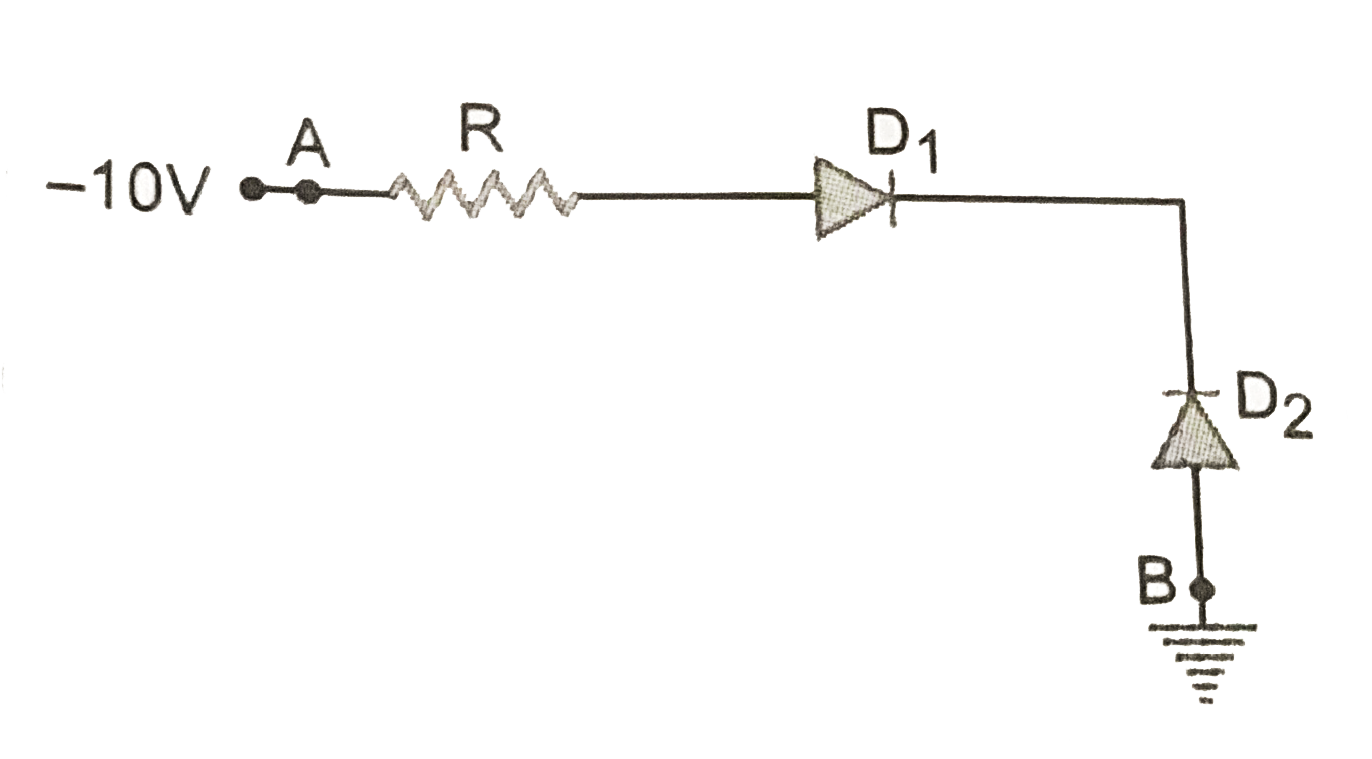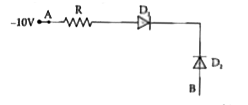Find the maximum voltage across AB in the circuit shown in Fig. Assume that diode is ideal.
 .
.
As the diode is treated ideal, its forward resistance Rf=zero. It acts as short circuit. So 10kΩ is in parallel with 15kΩ and the effective resistance across AB is
RAB=10×1510+15=10×1525=6kΩ
6kΩ is in series with 5kΩ
∴ total resistance
=RT=6kΩ+5kΩ=11kΩ,
V=30V. Current drawn from the battery is
I=VRT=30V11kΩ=2.72mA
VAB=IRAB=2.72mA×6kΩ=16.32V.
Topper's Solved these Questions
- SEMI CONDUCTOR DEVICESBOOK - NARAYNACHAPTER - SEMI CONDUCTOR DEVICESEXERCISE - C.U.Q
155 Videos
- SEMI CONDUCTOR DEVICESBOOK - NARAYNACHAPTER - SEMI CONDUCTOR DEVICESEXERCISE - Level-I (C.W)
21 Videos
- RAY OPTICS AND OPTICAL INSTRAUMENTS BOOK - NARAYNACHAPTER - RAY OPTICS AND OPTICAL INSTRAUMENTS EXERCISE - EXERCISE- 4 One or more than one correct answer type
13 Videos
- SEMICONDUCTOR ELECTRONICSBOOK - NARAYNACHAPTER - SEMICONDUCTOR ELECTRONICSEXERCISE - ADDITIONAL EXERCISE (ASSERTION AND REASON TYPE QUESTIONS :)
19 Videos
Similar Questions
Knowledge Check
In Fig.assuming the diode to be ideal
 AD1 is forward biased and D2 is reverse biased and hence current flows from A to BBD2 is forward biased and D1 is reverse biased and hence no current flows from B to A and vice versaCD1 and D2 are both forward biased and hence current flows from A to BDD1 and D2 are both reverse biased and hence no current flows from A to B and vice versa
AD1 is forward biased and D2 is reverse biased and hence current flows from A to BBD2 is forward biased and D1 is reverse biased and hence no current flows from B to A and vice versaCD1 and D2 are both forward biased and hence current flows from A to BDD1 and D2 are both reverse biased and hence no current flows from A to B and vice versaIn Fig assuming the diodes to be ideal :
 AD1 is forward biased and D2 is reverse biased and hence current flow form A to BBD2 is forward biased and D1 is reverse biased and hence no current flows from B to A and vice versaCD1andD2 are both forward biased and hence current flows from A to BDD1andD2 are both reverse biased and hence no current flows from A to B and vice-versa
AD1 is forward biased and D2 is reverse biased and hence current flow form A to BBD2 is forward biased and D1 is reverse biased and hence no current flows from B to A and vice versaCD1andD2 are both forward biased and hence current flows from A to BDD1andD2 are both reverse biased and hence no current flows from A to B and vice-versaIn Figure, assuming the diodes to be ideal,
 AD1 is forward biased and D2 is reverse biased and hence current flows from A to BBD2 is forward biased and D1 is reverse biased and hence no current flows from B to A and vice versa.CD1 and D2 are both forward biased and hence current flows from A to B.DD1 and D2 are both reverse biased and hence no current flows from A to B and vice versa.
AD1 is forward biased and D2 is reverse biased and hence current flows from A to BBD2 is forward biased and D1 is reverse biased and hence no current flows from B to A and vice versa.CD1 and D2 are both forward biased and hence current flows from A to B.DD1 and D2 are both reverse biased and hence no current flows from A to B and vice versa.
" Find the equivalent capacitance across AB for the circuit shown in fig.Every capacitor is having same capacitance "
View SolutionIn the following circuit, if the input wave form is as shown in the figure, what will be the wave form (i) across R in Fig. and (ii) across the diode in Fig. Assume that the diode is ideal.

View SolutionChoose the correct waveform that can represent the voltage across R of the following circuit, assuming the diode is ideal one :

View SolutionIn the circuit shown, the current through the ideal diode is

View SolutionA sinusoidal voltage of rms value 200 volt is connected to a diode and a resistor R in the circuit as shown in Fig., so that half wave rectification occurs. If the diode is ideal, what is the rms voltage across R? If resistor R is replaced by capactior of capacitance C, find the potential difference across C.

View Solution

